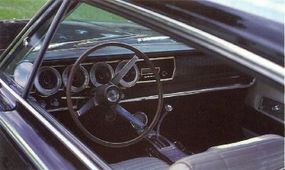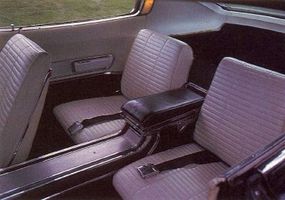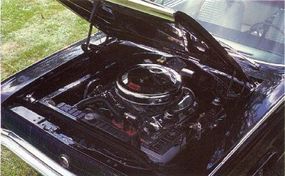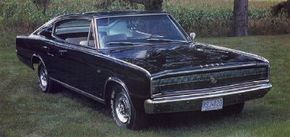Advertisement
Plymouth's 1964 Barracuda was America's first modern fastback, beating Ford's '65 Mustang 2+2 to market by about two weeks. Dodge waited until 1966 to join the fray, and then leaped in with the Charger 426 Hemi -- a muscle car other fastbacks could only dream of.
Plymouth's 1964 Barracuda was America's first modern fastback, beating Ford's '65 Mustang 2+2 to market by about two weeks. Dodge waited until 1966 to join the fray, and then leaped in with the Charger 426 Hemi -- a muscle car other fastbacks could only dream of.
Advertisement
To create the first Charger, Dodge basically added to its midsize Coronet two-door hardtop a rather graceless fastback roofline, hidden headlamps, and full-width taillamps. With a base price of $3,122, Charger cost $417 more than a Coronet 500 hardtop. Part of the deal was a state-of-the-art '60s interior: lots of chrome, four bucket seats (the rears folded down), available center consoles fore and aft, and full gauges.

A 318-cid V-8 was standard. The most-common performance upgrade was the optional 325-bhp 383 four-barrel, which would push a Charger through the quarter in the low 16s at 85 mph. But 1966 was also the year Chrysler's 426-cid Hemi V-8 came to the streets, and it made for the ultimate Charger.

Actual horsepower was near 500, but Dodge advertised its Street Hemi at 425 bhp on a 10.25:1 compression. A detuned version of the 12.5:l-compression race Hemi, the new customer version retained solid lifters but had a milder cam for smoother low-rpm running and a heat chamber so it could warm up properly. It also mounted its dual quads inline rather than on a cross-ram manifold. The engine added $1,000 to the price of a Coronet, or $880 to a Charger, and included stiffer springs and bigger (11-inch) brakes. Front discs were optional.

"Beauty and the beast," was how Dodge pitched its new Charger with the hot 426. "The Hemi was never in better shape," it boasted. Of 37,344 Chargers built for '66, however, only 468 got the Hemi. Maybe that's because Hemi buyers got a one-year/12,000 warranty instead of Dodge's usual 5/50,000. Even that, Chrysler warned, would be voided if the car was "subjected to any extreme operation (i.e., drag racing)." Heaven forbid.
Return to Classic Muscle Cars Library.
- Dodge muscle cars were among the fastest and wildest. See profiles, photos, and specifications of Dodge muscle cars.
- Muscle cars came in many shapes and sizes. Here are features on more than 100 muscle cars, including photos and specifications for each model.
- Muscle cars created their own culture. To learn about it, read How Muscle Cars Work.
These muscle car profiles include photos and specifications for each model:
- Cougar pulled out of Mustang's shadow with the striped and spoilered 1969 Mercury Cougar Eliminator.
- Beep, beep! Make way for one of the baddest muscle cars of all time, the 1970 Plymouth Road Runner Hemi.
- The 1970 Pontiac Firebird Trans Am combined sports-car handling and muscle car power.
- An all-aluminum, race-proven V-8 defined the rare and wicked 1969 Chevrolet Camaro ZL1.
For related car information, go to these articles:
- The engine is what gives a muscle car its flamboyant personality. To learn everything you need to know about car engines, see How Car Engines Work.
- Muscle cars wouldn't have much muscle without horsepower -- but what exactly is horsepower? How Horsepower Works answers that question.
- NASCAR race cars embody the muscle car philosophy of power. Read How NASCAR Race Cars Work to find out what makes these charged-up racers go.
- Are you thinking of buying a 2007 muscle car, or any other car? See Consumer Guide Automotive's New-Car Reviews, Prices, and Information.
Advertisement
